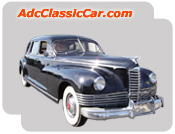Free business registration on ADCgo.com
Index
Chrysler Airflow - 1934-1937 | | Trains, planes even childrens toys were being streamlined in the 1930s, but when chrysler tried to shake up the automobile industry with a model based on aerodynamic principles, its new airflow was a flop. Nevertheless, the innovative design was to prove one of the most influential in automotive history. | Specifications performance
Top speed of about 90 mph
engine typedrivetrain: Side-valve, in¬line 8-cylinder
displacement 299-384.84 cu. In. (4.9-6.3 l) power rating 115-150 hp
transmission 3- and 4-speed; Overdrive available
chassis: Semielliptic leaf-spring suspension; Hydraulic brakes; 3,716-6,090 lbs.
price: $1,24545,145 |
|
|
|
| | About vehicle
Radical changes
developed under the direction of chrysler research director carl breer, the airflow design reduced air resistance by 40 percent, enhancing the cars speed and fuel economy. Because the design virtually eliminated the rear deck, the back seat was moved forward so that it no longer rested on the rear axle. This resulted in a smoother ride for back-seat passengers. The front seat and the engine were also moved farther forward, and both seats were wider than normal, accommodating six in comfort.
functional but not elegant
except for a 1934 series that was actually a de soto airflow with chrysler trim, all chrysler airflows were powered by eight-cylinder engines. Most were standard sedans or coupes, with some luxurious imperials, including
limousines, on longer wheelbases. But the public never warmed to a shape so radically different from the long hood and flowing fenders that defined styling elegance
With its aerodynamic shape and improved layout the chrysler airflow was a striking technical success but a marked commercial failure. |
Add business to ADCgo.com
|
|
|
Classic car sponsor search
programm |
|
|
|
|
|
Auto resources |
|
Auto drivers club
|
|
Auto yellow pages
|
|
Search system for local auto businesses
|
|
Auto Trader
|
|
Classic cars museum |
|
|
|
|
|
|
|


